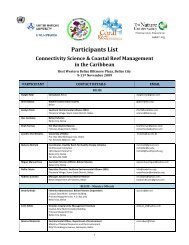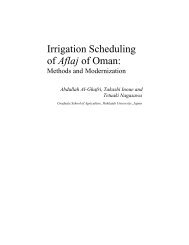The Global Water Crisis: Addressing an Urgent Security - Unu-inweh ...
The Global Water Crisis: Addressing an Urgent Security - Unu-inweh ...
The Global Water Crisis: Addressing an Urgent Security - Unu-inweh ...
Create successful ePaper yourself
Turn your PDF publications into a flip-book with our unique Google optimized e-Paper software.
3.2. Early doubts vis-à-vis progress <strong>an</strong>d achievements<br />
<strong>The</strong> AHDR points out that in 2010, the targets proposed in the <strong>Water</strong> Sector Strategy for 2010 have failed to be achieved,<br />
owing to <strong>an</strong> over-optimistic <strong>an</strong>d flawed <strong>an</strong>alysis (CPHD, 2011).<br />
Table 1. Afgh<strong>an</strong>ist<strong>an</strong>’s <strong>Water</strong> Sector Strategy 2008, targets <strong>an</strong>d progress (CPHD, 2011).<br />
For inst<strong>an</strong>ce, concerning water resources m<strong>an</strong>agement, the AHDR (2011) expresses doubt regarding the expected buy-in<br />
of local <strong>an</strong>d national actors in the new water govern<strong>an</strong>ce concepts at the sub-basin level. A key argument is the absence<br />
of a comprehensive <strong>an</strong>alysis justifying the relev<strong>an</strong>ce of IWRM, RBM <strong>an</strong>d MSP approaches in the specific context of the<br />
post-Talib<strong>an</strong> era. <strong>The</strong> authors of <strong>an</strong> earlier study in 2008 were already skeptical about the signific<strong>an</strong>ce of the achievements<br />
of new org<strong>an</strong>izations – seen as precursors for new river basin m<strong>an</strong>agement institutions – whether in terms of learning<br />
experiences or t<strong>an</strong>gible outputs (Varzi <strong>an</strong>d Wegerich, 2008).<br />
Furthermore, resolving the overarching issue of capacity 4 – whether institutional, hum<strong>an</strong> resources or knowledge based<br />
– reinforces the suspicion vis-à-vis IWRM <strong>an</strong>d RBM as a feasible option in the current development status of Afgh<strong>an</strong>ist<strong>an</strong>.<br />
Last but not least, the proposed reform requires a strong enforcement capacity (Islamic Republic of Afghnist<strong>an</strong>, 2007),<br />
something that is still lacking in the country’s current situation.<br />
3.3. Limited effectiveness in the adoption of River Basin M<strong>an</strong>agement principles <strong>an</strong>d<br />
participation<br />
A recent study (Thomas et al., forthcoming) covering the 2011 drought in northeastern Afgh<strong>an</strong>ist<strong>an</strong> highlights the<br />
disparity that seven years after the launch of the government’s pilot programme aimed at introducing the principles of<br />
good govern<strong>an</strong>ce promoted in the <strong>Water</strong> Law, local institutions still address their water allocation issues at the sub-basin<br />
level through procedures which fall far from the s<strong>an</strong>ctioned discourse on ‘good’ water govern<strong>an</strong>ce. For inst<strong>an</strong>ce, while<br />
institutional reform includes the devolution of decision-making power to water users, with the government taking a more<br />
advisory <strong>an</strong>d facilitation role, the reality in the Lower-Kunduz Sub-Basin (LKSB) shows that local government actors still play<br />
a major role in decision-making, <strong>an</strong>d are keen to skip participatory processes when the power bal<strong>an</strong>ce is in their favour.<br />
Similarly, although the <strong>Water</strong> Law discusses tr<strong>an</strong>slating existing water rights into permits, it is the traditional system of<br />
ab<strong>an</strong>dâz – which does not formally recognize the rights of downstream communities within the sub-basin – which remains<br />
firmly applied. Additionally, the govern<strong>an</strong>ce model behind the <strong>Water</strong> Law praises decentralization in decision-making;<br />
however, the reality in the Taloq<strong>an</strong> Sub-Basin (TSB) shows that Parliament, central Ministries <strong>an</strong>d even the President’s<br />
4 <strong>The</strong> capacity challenge was already highlighted in <strong>an</strong> early draft of the WSS in 2007 (Islamic Republic of Afgh<strong>an</strong>ist<strong>an</strong>, 2007).<br />
116 <strong>The</strong> <strong>Global</strong> <strong>Water</strong> <strong>Crisis</strong>: <strong>Addressing</strong> <strong>an</strong> <strong>Urgent</strong> <strong>Security</strong> Issue<br />
Target Progress (2011)<br />
<strong>Water</strong> resources m<strong>an</strong>agement: Provide 30% of irrigation<br />
water from large water works by establishing river basin<br />
org<strong>an</strong>izations (for example, river basin councils, sub-basin<br />
councils <strong>an</strong>d related agencies) in Balkh, Kunduz <strong>an</strong>d the<br />
western region by the end of 2010.<br />
Urb<strong>an</strong> development: In conformity with the Millennium<br />
Development Goals, greater investment in water supply<br />
<strong>an</strong>d s<strong>an</strong>itation will ensure that 50% of households in Kabul<br />
<strong>an</strong>d 30% of households in other major urb<strong>an</strong> areas will have<br />
access to piped water <strong>an</strong>d improved s<strong>an</strong>itation by the end<br />
of 2010.<br />
Rural development: By the end of 2010, access to safe<br />
drinking water will be extended to 90% of villages, <strong>an</strong>d<br />
access to s<strong>an</strong>itation to 50% of villages.<br />
Not achieved. No river basin agency or<br />
river basin council has been established.<br />
WUAs have been established, but only<br />
informally; they lack legal status.<br />
Herat (85%), Kunduz (50%) <strong>an</strong>d Mazar-i-<br />
Sharif (70%) have met the target. Kabul,<br />
K<strong>an</strong>dahar <strong>an</strong>d N<strong>an</strong>garhar have not.<br />
Current rural access to safe drinking<br />
water sources is 20% .<br />
(see chapter 3). -<br />
<strong>The</strong> current rate of progress of 1% per<br />
year me<strong>an</strong>s that the target will not be<br />
reached within the next few decades.




